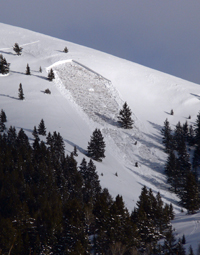Janet Kellam gets paid to worry.
The head of Ketchum's Sawtooth National Forest Avalanche Center, Kellam and two other avalanche forecasters combine extensive field observations with detailed weather forecasting to come up with the daily avalanche advisories that local skiers, snowboarders and snowmobilers rely on as they head into the snowbound hills.
They trio whips up this bit of magic and science from their cramped quarters at the Ketchum Ranger Station. Though their primary focus is the mountains immediately surrounding the Wood River Valley, the crew also keeps an eye on the avalanche risks in the northern Sawtooth Mountains near Stanley, the western Smoky Mountains and Fairfield-area Soldier Mountains. It's a lot of country to cover.
But for all the many miles of south-central Idaho high country she's responsible for keeping watch over from about November to June, Kellam worries most about a series of enticing backcountry lines closer to home.
"I am concerned about out-of-bounds Baldy," she said. "Very much so."
Last year's Castle Rock Fire—which burned dense evergreen stands on the south, west and north-facing backside of 9,151-foot-tall Bald Mountain—has only served to emphasize Kellam's worry. Nowadays, just about everyone has heard of the bounty of lines opened up by the blaze in late summer of 2007.
Kellam believes we've been exceedingly lucky so far. Though numerous skiers and boarders sampled the new out-of-bounds goods last winter, the season ended with nary an injury or fatality there. The same went for the rest of the center's large forecast area.
She said the last person to die in an avalanche in the local area was in 2006 when a snowmobiler got buried in the Deer Creek area of the southern Pioneer Mountains.
Still, Kellam is about as certain as she can be that there were numerous close calls last winter. She said the near misses may lull people into a false sense of security that the backside of Baldy is a safe place to play.
"We have quite a bit that goes unseen," she said.
Kellam worries about the potential for skiers or boarders to set off an avalanche that races down to someone below. Another concern is the likelihood that conditions may have changed in the past year due to the loss of tree cover. She said that could create different wind currents, which could alter the snowpack.
Though many in the ski world refer to lift-accessed out-of-bounds skiing as "side-country," people shouldn't take Baldy's backside lightly, she said.
"If people go out-of-bounds, they have to know it's full-on backcountry," she warned.
Kellam does see a silver lining in the local backcountry avalanche scene. Though the 2007-08 winter was a record-setting season on the national stage in terms of the number of avalanche-caused fatalities—36 people lost their lives in the backcountry last year—none happened in the Sawtooth Avalanche Center's forecast area.
Kellam believes there are two reasons for that. First, she thinks local backcountry skiers, snowboarders and snowmobilers are becoming more educated in general and making good decisions. But just as importantly, Kellam believes we've been lucky.
It's not like the Wood River Valley dodged the avalanche bullet last winter. In fact, Kellam and the rest of the Sawtooth National Forest Avalanche Center crew were kept hopping as a series of storms in January caused a number of large slides to create havoc in, of all places, residential areas.
The slides were caused by storms that combined rapid snowfall and fierce winds, a common recipe for high avalanche danger. Most impacted by the residential avalanche cycles last winter were the Warm Springs and Eagle Creek drainages. Several homes in these areas saw extensive damage as snow swept over them.
Also last winter, several school-age children were seen hiking up an open west-facing slope next to the Wood River High School where a moderate-sized avalanche later roared down toward the school grounds.
Fortunately, no one was injured by any these slides. But because of the danger the storms were creating in local residential areas, Kellam and her counterparts stuck closer to town throughout much of last winter.
"We felt that was where we could be most effective," she said. "It was wild."
Though she's encouraged by the number of gear innovations that have been developed in recent years to keep backcountry users safer in avalanche country, Kellam wants to remind people that they're no substitute for using one's greatest avalanche safety asset: their brains.
Up to a third of avalanche fatalities are caused by bodily trauma as victims are slammed against trees, rocks and other natural features, Kellam said.
"We have lots of trees and rocks in our terrain for someone to hit if they are barreling downhill in a slide," she said.
Looking to the hills several weeks back, Kellam said she's seeing a mixture of good and bad. Up in the highest reaches of local mountains, a shallow snowpack has hung on for some time, creating the potential for a weak snowpack that could last through much of the winter.
"Right now it's looking like we're going to have some problems up high," she said.
Lower down, the warmer temperatures have kept the ground clear, meaning that once the snow does fall it will likely bond much better, Kellam said.
Whatever happens this winter, backcountry adventurers should make their first stop before heading out the avalanche center's Web site—at www.sawtoothavalanche.com—where daily forecasts are posted. The forecast can also be listened to at 622-8027.
Information on a number of local avalanche educational opportunities can also be found at the center's Web site.


 It doesn’t take much of a slope angle for avalanches to get going. Photo by
It doesn’t take much of a slope angle for avalanches to get going. Photo by



































